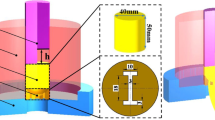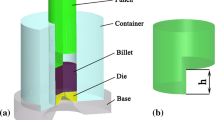Abstract
Staggered extrusion (SE) is a new method to solve the bottleneck of traditional curvature products, such as long manufacturing cycle, many forming processes and difficult quality control. How to quantitatively control the curvature of extruded products is the key to implement this method. Herein, the upper bound method is used to calculate and analyze the power consumption of each characteristic zone in the SE process. The theoretical model of extrusion load and curvature is established. The bending radius of profile Rc under different staggered distance h and the extrusion ratio λ is calculated. The reciprocal relationship between curvature radius Rc and curvature κ is used to obtain the curvature change relationship. The results show that the staggered distance h has an important influence on the curvature κ. When the staggered distance h increases from 8 to 24 mm and other conditions remain unchanged, the curvature κ increases from 0.0546 to 0.1607. Any combination of the staggered distance h and the extrusion ratio λ corresponds to an eccentricity ratio ξ. The eccentricity ratio ξ decreases with the increase of the staggered distance h or the extrusion ratio λ. By comparison, it can be seen that the variation trend of the theoretical predicted value and the FE modeling in the steady-state extrusion stage is consistent. The experimental results are in good agreement with the curvature theory prediction model. These results provide a scientific basis for the formulation of the SE process and precisely controlling magnesium alloy curvature products.










Similar content being viewed by others
Availability of data and materials
The data obtained in the framework of this study are available to the journal upon request.
Abbreviations
- D 1 :
-
Diameter of the billet
- D 2 :
-
Diameter of the extruded profile
- S 0 :
-
Cross-sectional area of the billet
- S 1 :
-
Cross-sectional area of the extruded profile
- S 2, S 3, S 4, S 5 :
-
Cross-sectional area of the related profile
- h :
-
Staggered distance
- Δv, Δv 1, Δv 2, Δv 3, and Δv 4 :
-
Amount of velocity discontinuity
- v 1 :
-
Extrusion velocities of the stem
- v 2, v 3 :
-
Velocity at the mass center of the related profile
- v o :
-
Velocity at the center of the extruded profile
- v I, v II :
-
Velocity in zones I and II
- v 1e, v 2e :
-
Maximum and minimum material flow velocity across the die exit
- v z :
-
Material flow velocity at a certain point of the die
- F 1 :
-
Extrusion force of stem
- Ẇ, Ẇ 0 :
-
Internal and external plastic dissipation power
- Ẇ i, Ẇ Γ, Ẇ S :
-
Plastic dissipation power due to plastic deformation, velocity discontinuity surface, and frictional force
- ͞y i :
-
Coordinates of the mass center of the related profile
- V i :
-
Volume of the related profile
- O2, O3 :
-
Mass
- Δt :
-
A very short time
- Δd 2, Δd 3 :
-
The distance traveled in a very short time
- R c :
-
Bending radius of profile
- α, β, θ :
-
Angles in Fig. 2
- l 0 :
-
Distance between container and die
- l 1 :
-
Die land length
- l 2 :
-
Distance between point B and die exit
- l 3 :
-
Distance between the first-touched billet part and die
- λ :
-
Extrusion ratio
- ξ :
-
Eccentricity ratio
- τ :
-
Shear stress
- μ :
-
Constant coefficient of friction
- ε ij*:
-
Strain rate tensor
- σ ij*:
-
Strain tensor
- κ :
-
Curvature
References
Hasegawa O, Manabe K, Murai T (2014) Stretch press bending of AZ31 magnesium alloy extruded square tube. Procedia Engineering 81:2184–2189
Ren WJ, Li JJ, Xin RL (2019) Texture dependent shifting behavior of neutral layer in bending of magnesium alloys. Scripta Mater 170:6–10
Shi YJ, Guo YK, Wang XG, Sun R, Li XF (2021) Laser bending angle and surface quality with preload at low heating temperature. Opt Laser Technol 136:106755
Murata M (1996) Effects of inclination of die and material of circular tube in MOS bending method. Trans Jpn Soc Mech Eng 62(601):3669–3675
Chatti S, Hermes M, Tekkaya AE, Kleiner M (2010) The new TSS bending process: 3D bending of profiles with arbitrary cross-sections. CIRP Ann 59(1):315–318
Kleiner M, Tekkaya AE, Becker D, Pietzka D, Schikorra M (2009) Combination of curved profile extrusion and composite extrusion for increased lightweight properties. Prod Eng Res Devel 3(1):63–68
Khalifa NB, Becker D, Schikorra M, Tekkaya AE (2008) Recent developments in the manufacture of complex components by influencing the material flow during extrusion. Key Eng Mater 367:55–62
Becker D, Schikorra M, Tekkaya AE (2008) Manufacture of 3D curved profiles for structure components. Adv Mater Res 43:1–8
Müller KB (2006) Bending of extruded profiles during extrusion process. Int J Mach Tools Manuf 46(11):1238–1242
Shiraishi M, Nikawa M, Goto Y (2003) An investigation of the curvature of bars and tubes extruded through inclined dies. Int J Mach Tools Manuf 43(15):1571–1578
Shiraishi M, Nikawa M, Kubota T, Goto Y (2007) Prediction of curvatures of parts extruded through rotary die using fuzzy inference. J Mater Process Technol 187–188:702–705
Takahashi Y, Kihara S, Yamaji K, Shiraishi M (2015) Effects of die dimensions for curvature extrusion of curved rectangular bars. Mater Trans 56(6):954–958
Zhou WB, Lin JG, Dean TA, Wang LL (2017) A novel application of sideways extrusion to produce curved aluminium profiles: feasibility study. Procedia Engineering 207:2304–2309
Zhou WB, Lin JG, Dean TA, Wang LL (2018) Feasibility studies of a novel extrusion process for curved profiles: experimentation and modelling. Int J Mach Tools Manuf 126:27–43
Zhou WB, Yu JQ, Lin JG, Dean TA (2019) Manufacturing a curved profile with fine grains and high strength by differential velocity sideways extrusion. Int J Mach Tools Manuf 140:77–88
Zhou WB, Yu JQ, Lin JG, Dean TA (2020) Effects of die land length and geometry on curvature and effective strain of profiles produced by a novel sideways extrusion process. J Mater Process Technol 282:116682
Kazanowski P, Browne HM, Libura W, Misiolek WZ (2005) Mechanical and microstructural performance of convex dies in axisymmetric extrusion-theory and experimental verification. Mater Sci Eng, A 404(1–2):235–243
Zhou WB, Lin JG, Dean TA, Wang LL (2018) Analysis and modelling of a novel process for extruding curved metal alloy profiles. Int J Mech Sci 138–139:524–536
Zhou WB, Shi ZS, Lin JG (2018) Upper bound analysis of differential velocity sideways extrusion process for curved profiles using a fan-shaped flow line model. Int J Lightweight Mater Manuf 1(1):21–32
Altinbalik T, Ayer O (2013) Effect of die inlet geometry on extrusion of clover sections through curved dies: upper bound analysis and experimental verification. Trans Nonferrous Metals Soc China 23(4):1098–1107
Wang YP, Li F, Shi WY, Li XW, Fang WB (2019) Microstructure, bending behavior and texture evolution of AZ31B magnesium alloy bending products processed by staggered extrusion (SE). Mater Charact 155(9):109842
Wang YP, Li F, Wang Y, Li XW, Fang WB (2020) Effect of extrusion ratio on the bending behavior, microstructure and texture evolution of AZ31 magnesium alloy by the staggered extrusion (SE). J Magnes Alloys 8(4):1304–1313
Wang YP, Li F, Shi WY, Li XW, Fang WB (2019) Dynamic recrystallization and metal flow behavior of AZ31 magnesium alloy bending products processed by staggered extrusion. J Mater Eng Perform 28(6):3551–3559
Chen L, Zhang JX, Tang JW, Chen GJ, Zhao GQ, Zhang CS (2018) Microstructure and texture evolution during porthole die extrusion of Mg-Al-Zn alloy. J Mater Process Technol 259:346–352
Funding
This project is supported by the National Natural Science Foundation of China (No. 51975166).
Author information
Authors and Affiliations
Contributions
Staggered extrusion process is a new method for bending products forming integrated. The theoretical model established by upper bound method lays a foundation for controlling the bending products curvature.
Corresponding authors
Ethics declarations
Ethical approval
Not applicable.
Consent to participate
Not applicable.
Consent for publication
Not applicable.
Competing interests
The authors declare no competing interests.
Additional information
Publisher's Note
Springer Nature remains neutral with regard to jurisdictional claims in published maps and institutional affiliations.
Rights and permissions
About this article
Cite this article
Zhang, X.J., Li, F., Wang, Y. et al. An analysis for magnesium alloy curvature products formed by staggered extrusion (SE) based on the upper bound method. Int J Adv Manuf Technol 119, 303–313 (2022). https://doi.org/10.1007/s00170-021-08167-z
Received:
Accepted:
Published:
Issue Date:
DOI: https://doi.org/10.1007/s00170-021-08167-z




